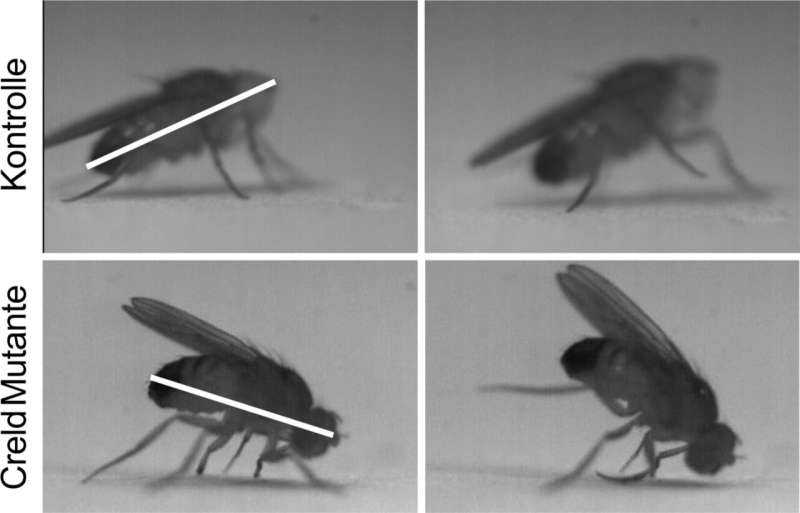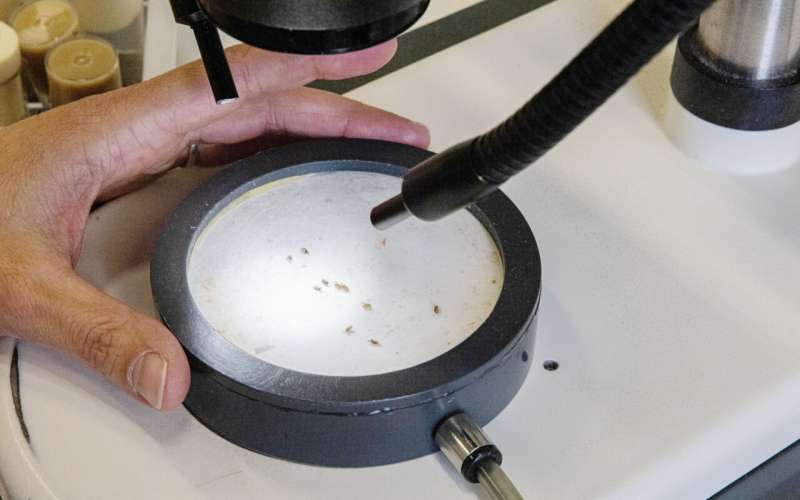Genetic defect leads to motor disorders in flies

In their study, the research groups looked at a protein called Creld. A study from Bonn had recently been able to demonstrate that Creld plays an important role in the development of the heart in mammals. "We wanted to find out exactly what the protein does," explains Dr. Margret Helene Bülow, a lecturer at the LIMES Institute of the University of Bonn.
For this purpose, the researchers studied fruit flies of the genus Drosophila, which they had genetically modified in such a way that they cannot form Creld. In the animals, the heart rate was slowed in a characteristic way—a sign of energy deficiency. They also exhibited severe motor disorders. Mitochondria are responsible for providing energy, and their malfunction can result in the death of nerve cells that are responsible for motor function in humans. The clinical picture is known as Parkinson's disease.
"So Creld may play an important role not only in impaired heart function, but also in Parkinson's disease," says Dr. Nicole Kucharowski of the LIMES Institute, who, along with her colleague Marie Paradis, conducted a key part of the experiments in the study. "The findings of a recent analysis are consistent with this. It suggests that Creld production is often reduced in Parkinson's patients."
But just how Creld might be related to Parkinson's was puzzling: The protein is not found in mitochondria at all. It can be detected exclusively in a widely branched network of tubes that serves to produce various molecules in the cell—the endoplasmic reticulum (ER). How can it interfere with the function of cellular power plants from there?
Pesticide suspected of causing Parkinson's disease
To find out, the researchers administered small amounts of a pesticide to healthy fruit flies (i.e., those that can form Creld). It contains the active ingredient rotenone, which is suspected of triggering Parkinson's disease in humans. Rotenone acts directly in the mitochondria by inhibiting a key step in energy production. After administration of the pesticide, the flies showed motor disorders similar to those of the Creld mutants. "We also found that their mitochondria are very often in contact with the ER," Bülow explains.
In further experiments, the researchers were able to show that certain classes of lipids are transported from the ER to the mitochondria during this contact. These so-called phospholipids rekindle the step in energy production that is inhibited by rotenone. With assistance from the ER, the mitochondria try to ramp up the energy supply again in this way. "And the availability of Creld seems to be crucial for this transfer of phospholipids," Bülow points out. "In flies that cannot form Creld, phospholipids accumulate in the contact sites between ER and mitochondria. So they don't get transported to the mitochondria, but accumulate."

Creld increases energy production in the cell
Creld is therefore important for increasing energy production in the cell. This is in line with the observation that Drosophila mutants without Creld produce hardly any hydrogen peroxide in their mitochondria—this is a molecule produced as a waste material during the work of the power plants. Hydrogen peroxide can damage cells. Until now, it was thought that it was produced in excessive amounts in people with Parkinson's or that it was not adequately disposed of. This would gradually poison the nerve cells responsible for motor function.
It is possible, however, that another effect might cause their demise—namely, the chronic undersupply of energy triggered by damage to or underproduction of Creld. "This is a thesis that we now need to investigate further," says Bülow, who is a member of the Transdisciplinary Research Area "Life and Health" at the University of Bonn.
The current success is also the result of a successful cooperation. For instance, essential parts of the work were carried out at the University of Osnabrück. Dr. Julia Sellin, who originally helped initiate the study, has also recently moved to the University Hospital in Aachen. "The collaboration with Prof. Dr. Christoph Thiele from the Cluster of Excellence Immunosensation2 here at the University of Bonn also went extremely well," says Bülow.
The research was published in Science Advances.
More information: Marie Paradis et al, The ER protein Creld regulates ER-mitochondria contact dynamics and respiratory complex 1 activity, Science Advances (2022). DOI: 10.1126/sciadv.abo0155. www.science.org/doi/10.1126/sciadv.abo0155
Journal information: Science Advances
Provided by University of Bonn



















